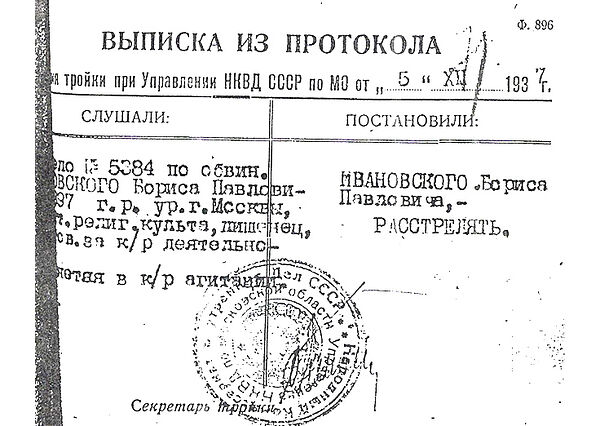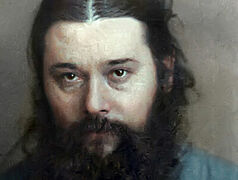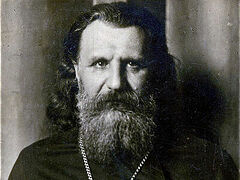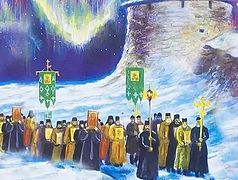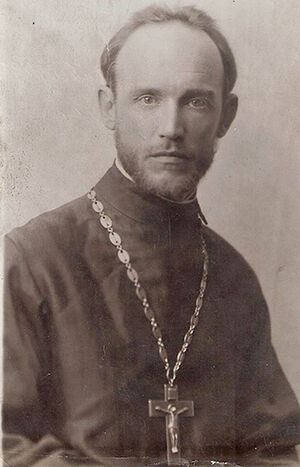 Hieromartyr Boris Pavlovich Ivanovsky The past era of the confessors has left a noticeable mark on world history and the history of the Russian Church. For many of our fellow-countrymen and relatives, the revolutionary events became a litmus test that showed people’s true spiritual condition. This above all applies to the clergy, since it was the Church that, in addition to the monarchy, was the basis of the type of state that went down in history. The persecutions, privations and torments demonstrated that true Christianity is, like pure gold, tried in a furnace of earth, purified seven times (Ps. 11:7).
Hieromartyr Boris Pavlovich Ivanovsky The past era of the confessors has left a noticeable mark on world history and the history of the Russian Church. For many of our fellow-countrymen and relatives, the revolutionary events became a litmus test that showed people’s true spiritual condition. This above all applies to the clergy, since it was the Church that, in addition to the monarchy, was the basis of the type of state that went down in history. The persecutions, privations and torments demonstrated that true Christianity is, like pure gold, tried in a furnace of earth, purified seven times (Ps. 11:7).
One of the examples of a genuine Christian and confessor was Hieromartyr Boris Ivanovsky (feasts: November 27 / December 10—the date of his martyrdom, and January 25 / February 7—the Synaxis of the New Martyrs of the Russian Church), who served in the Holy Trinity Church in Listy, in central Moscow.
Boris Pavlovich Ivanovsky was born in 1897 in Moscow to the family of postal employee Pavel Ivanovsky. During the First World War, Boris Pavlovich studied at a gymnasium (a classical school) and then at a non-classical secondary school. When the Russian Telegraph Agency was established in 1918, thanks to the Boris’s education he got a job at the Agency doing editorial work.1
According to the recollections of Kira Petrovna Solntseva, Fr. Boris’s niece, “In 1920–1921, Boris Pavlovich Ivanovsky decided to become a priest.”2 He had made a conscious Christian choice of voluntary confession of the faith in the face of persecutions from the godless government that were to come. Before Boris Pavlovich’s very eyes, “churches are being destroyed and clergy are being killed. He knows everything happening in upper Church circles,” but nevertheless, “he was raised in the atmosphere of the Russian Orthodox clergy and cannot tolerate what is happening,”3 the priest’s niece recalled. Boris Pavlovich entered the Moscow Theological Seminary, at that time headed by Archpriest Vladimir Strakhov—an authoritative Moscow priest whom Fr. Boris afterwards succeeded as rector of the Holy Trinity Church in Listy. Around that period, Boris Pavlovich married Maria Nikolaevna, “a beautiful, stately woman who loved her husband with all her heart and waited for him for twenty years after his arrest.”4 At that time, the Ivanovsky family lived at 13 Bolshoy Sukharevsky Lane (apartment no. 36).
 On graduating from seminary and after his ordination in 1923, the first place of the pastor’s ministry became the Church of the Deposition of the Robe of the Mother of God in the former village of Leonovo, and his new home was at 16 1st Leonovskaya Street, not far from the church. At that time his wife Maria sang in the choir of the Church of the Deposition of the Robe of the Theotokos. The beginning of Fr. Boris’ ministry coincided with a tragic event: In 1923 his three-year-old daughter passed away and was buried beside the church where her father served. Then Fr. Boris was sent to bear the cross of ministry to various churches of the Pavlovsky Posad district of the Moscow region.5
On graduating from seminary and after his ordination in 1923, the first place of the pastor’s ministry became the Church of the Deposition of the Robe of the Mother of God in the former village of Leonovo, and his new home was at 16 1st Leonovskaya Street, not far from the church. At that time his wife Maria sang in the choir of the Church of the Deposition of the Robe of the Theotokos. The beginning of Fr. Boris’ ministry coincided with a tragic event: In 1923 his three-year-old daughter passed away and was buried beside the church where her father served. Then Fr. Boris was sent to bear the cross of ministry to various churches of the Pavlovsky Posad district of the Moscow region.5
Then came the 1930s, the most difficult years for the Russian Church. Tens of thousands of clergymen, along with the minor orders and laity, were shot, hundreds were repressed, churches were closed or blown up, aiming to erase our spiritual heritage from the people’s memory forever. All of that was happening under Fr. Boris and his family’s very eyes.
In this sorrowful time, Fr. Boris had to share the burden with his brothers in Christ. Fr. Boris’s niece recalled the words of his wife Maria: “Borechka [an affectionate form of the name Boris.—Trans.] is always quiet and kind. The parishioners respected and loved him. In his sermons he only exhorted everybody to defend the Orthodox faith and stand up for the Church.”6 Maria genuinely wondered what “the bone of her bones” and “flesh of her flesh” (cf. Gen. 2:23) had been arrested for. Her pure soul was alien to that diabolical malice towards the Church and towards the truth then saturating the air around them.
In 1930, Fr. Boris was arrested on suspicion of “anti-Soviet agitation.” The case was related to the posting of “counter-revolutionary” leaflets on the walls of the former Holy Protection and St. Basil’s Convent7 “in the month of November”, as the priest himself later testified during interrogation.8
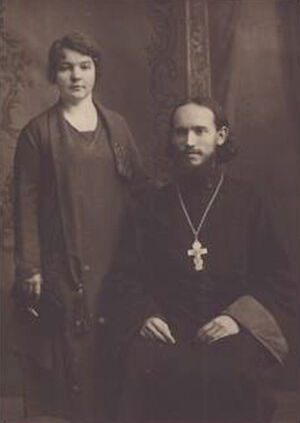 But the pastor remained under arrest for only two weeks, after which he was released for lack of evidence.9 The arrest may have served as a pretext for his subsequent transfer to Moscow in late 1930.
But the pastor remained under arrest for only two weeks, after which he was released for lack of evidence.9 The arrest may have served as a pretext for his subsequent transfer to Moscow in late 1930.
In Moscow, Archpriest Boris was assigned to the Church of the Holy Trinity in Listy, where he served alongside his family who still lived at Sukharevsky Lane. Fr. Boris was destined to succeed Archpriest Vladimir Strakhov, who had been arrested at the same time but never returned to his church. Fr. Boris served at the Holy Trinity Church right until it was closed in 1933. According to the Ivanovsky family tradition, after the closure of the Holy Trinity Church, Fr. Boris served at the St. Nicholas Church in Drachi (Grachi) at 38 Trubnaya Street. In 1937, that church was demolished together with the architectural ensemble of an ancient monastery that had surrounded it.
The next place of the pastor’s ministry was the Church of St. Gregory of Neocaesaria at Bolshaya Polyanka Street. He resided in the aforementioned Leonovo at the address: “Leonovo, house 16, apartment 1”, together with two other priests, namely Hieromartyr Pavel Felitsin (who served in the Church of the Deposition of the Robe of the Mother of God) and the Renovationist Priest Alexander Kedrov (who served in the church at the Pyatnitskoye Cemetery in Moscow that then belonged to schismatics). All three priests were arrested at the same time on November 15, 1937 and sent to the Taganskaya Prison (“Taganka”) in Moscow. For a time, Leonovo was bereft of its spiritual fathers, and the abomination of desolation reigned in the Church of the Deposition of the Robe right until 1942.
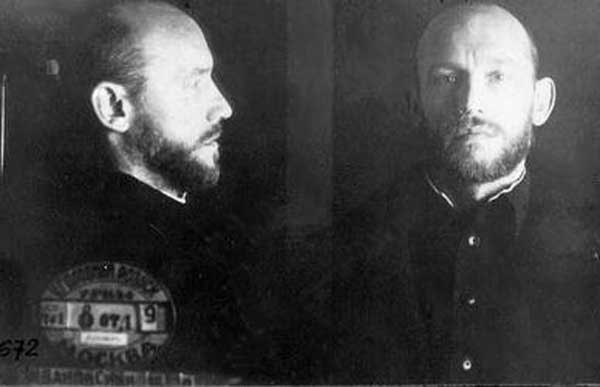 Hieromartyr Boris Pavlovich Ivanovsky
Hieromartyr Boris Pavlovich Ivanovsky
Remarkably, during interrogation on November 16, 1937, when asked about his relatives, the priest indicated only his wife and his brother Constantine who then worked as a doctor and did not attract the attention of the NKVD [the secret police agency in the Soviet Union which absorbed the functions of the former OGPU in 1934.—Trans.]. Aware of the risk of false testimony, Fr. Boris deliberately did not indicate his family members living at Sukharevsky Lane, thus saving them from imminent arrest. According to the reminiscences of Fr. Boris’ niece:
“He is silent, while knowing that the whole testimony is verified by the OGPU [an organization for investigating and combating counter-revolutionary activities in the Soviet Union.—Trans.] He deliberately conceals this fact, no matter what the cost. But the OGPU is in a hurry. There is a lot of work. There is no time to verify the testimony of the person under investigation, although there is a stamp about a certain verification on the first page of the ‘questionnaire’.” 10
According to available information, the Renovationist Priest Alexander Kedrov testified under interrogation:
“I have served as a priest since 1919; earlier I was a Tikhonite, but from 1935 I began to gradually move away from the Tikhonites [as the Renovationists called the Patriarchal Church at that time.—Trans.], while Felitsin and Ivanovsky are convinced Tikhonites and show great anger towards the Soviet regime. Boris Ivanovsky would say to me, ‘Our time will come when we will grind all Communists into dust and wipe them off the face of the earth.’ I condemned such convictions and did not support them.”
This testimony became a catalyst for the reaction owing to which we now have Priests Boris Ivanovsky and Pavel Felitsin among the host of the Russian New Martyrs.
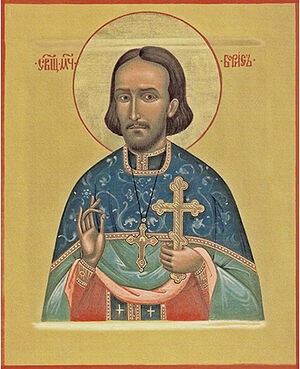 Fr. Boris’ interrogation protocol has been preserved:
Fr. Boris’ interrogation protocol has been preserved:
“The church in which I serve belongs to the Tikhonites. I am a convinced Tikhonite too and belong to no other Church groups.”
“Whom of the ministers of the religious cult in Leonovo do you know?” the investigator asked.
“In Leonovo I know Priests Kedrov and Pavel Felitsin who lived there.”
“Where did you gather with the priests you have named?”
“I did not gather anywhere together with the named individuals except for occasional meetings in passing.”
“You are giving false testimony, since it is known that you, having gathered together, carried out counter-revolutionary agitation.”
“No, I do not confirm this information and deny it. I did not carry out any anti-Soviet agitation, except that as a priest I have a duty to motivate citizens to believe in God.”11
A similar interrogation was carried out in relation to Archpriest Pavel Felitsin.12 On December 5, the NKVD troika sentenced Archpriest Pavel to ten years in a forced labor camp13 and condemned Archpriest Boris to execution by shooting. The other accused clergymen and laymen were sentenced to various terms of imprisonment in a forced labor camp. Regarding Fr. Boris, the sentence was implemented five days later—on December 10. He was executed by firing squad and buried at the Butovo Shooting Range.
The NKVD told his wife Maria that Fr. Boris had been sentenced to ten years “without the right of correspondence.” She waited for him for twenty years right until her own death in 1957, firmly believing that her husband would return home.

